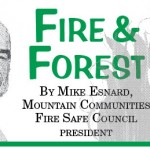As winter wears on, Hill residents occasionally escape the cold with a jaunt down California Scenic Highway 74 to the desert. Driving it today, we forget that prior to 1932 the only way to get directly to Idyllwild from Coachella Valley was on foot or horseback.
The automotive alternative involved traveling around the foot of the San Jacinto range to Banning or Hemet, then up a steep, single-lane, dirt road. Worse yet, reaching the Pinyon Flats area, which visibly taunted sweltering desert dwellers who coveted its cool summer nights, was a 100-mile journey via Keen Camp (today’s Living Free animal sanctuary). From there travelers used even more primitive roads through gates on the Garner Ranch and across Vandeventer Flat.
How the highway came to be is a tale far more convoluted than, say, the recently completed quest for a larger library building. You’ll find the whole story, as detailed by my colleague, Steve Lech, in his new book, “For Tourism and a Good Night’s Sleep” (available in the Idyllwild Area Historical Society’s Museum Shop).
The idea was first elaborated in 1919 as a tourist magnet by Arthur Lovekin, longtime champion for creation of the Mt. San Jacinto State Park, and County Supervisor C. Rowley Smith, who would later turn up in Idyllwild as money manager for Walter Wood’s ill-fated golf club on Saunders Meadow. They proposed following the old Rincon Trail up Palm Canyon from Palm Springs to Pinyon.
A competing proposal soon emerged from the population center of Coachella Valley, Indio, led by newspaper editor J. Winfield Wilson. (Palm Springs was still a sleepy village of 70 residents.) Indio residents were more interested in quickly escaping summer’s heat, and their answer was a shorter, more easterly route to Pinyon, the so-called “Dead Indian Trail” up Carrizo Canyon from the future site of Palm Desert.
The matter was further muddied by advocates of a mountain state park, who pushed for a still shorter route up the West Fork of Palm Canyon and across the Desert Divide to Keen Camp.
County Surveyor A. C. Fulmor, who never saw a road proposal he wouldn’t love to implement, eagerly and repeatedly surveyed the several proposed routes during the 1920s. Extreme terrain and exorbitant cost ruled out the West Fork route, but he pronounced the other two feasible, using existing roads between Pinyon and Keen Camp.
The county board of supervisors found itself caught between advocates of the eastern route, which promised to cost 30 percent less, and Palm Canyon advocates from Palm Springs and especially Los Angeles, where most tourists would originate, and where a wealthy Chamber of Commerce could wield influence with the state.
One constituency nobody thought to consult was the Cahuilla Indians, whose reservation lands would have to be crossed both in Palm Canyon and on Vandeventer Flat. In the end they played the winning cards. The Agua Caliente Cahuilla band refused to grant a right-of-way up Palm Canyon, but only after the Palm Springs Chamber of Commerce abruptly switched its support out of concern for potential traffic damage to the canyon’s scenic quality. A similar standoff over Vandeventer Flat with the Santa Rosa band was soon resolved through personal diplomacy by Win Wilson.
This cleared the way to complete construction from Keen Camp to the desert, giving rise to the official name “Pines to Palms.” The gravel road opened in July 1932, but was not paved until 1937, when the state pitched in.
The saga produced other stories, such as Pinyon’s development by Arthur Nightingale, who built the Sugarloaf Café, and Wilson Howell’s Ribbonwood rest stop and rustic cabins, now supplanted by the failed Spring Crest resort development. But for those you’ll have to consult Lech’s book.










